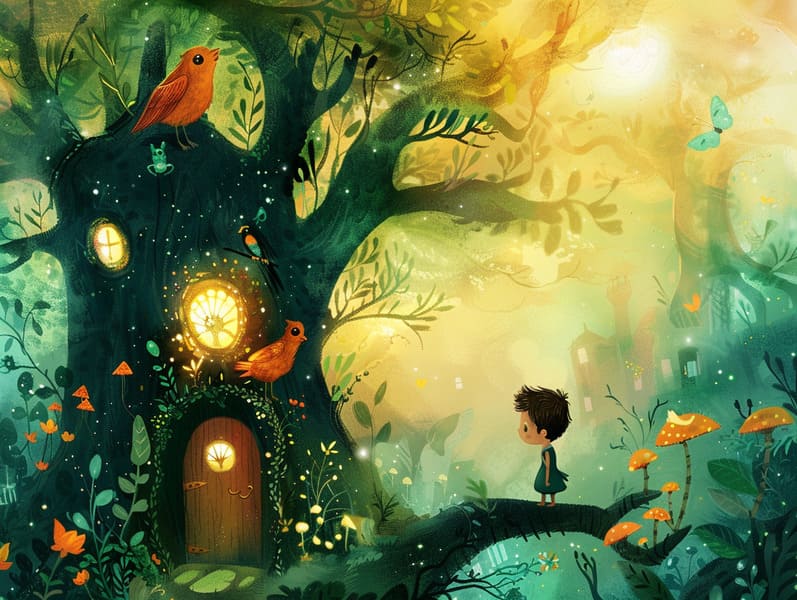The Magic of Evening Adventures: Building Beloved Occasions with Your Loved Ones
The Magic of Evening Adventures: Building Beloved Occasions with Your Loved Ones
Blog Article

Evening is a important time for parents and children. It’s a time to unwind, nestle in, and delight in the joy of stories.
For lifetimes, children's bedtime stories have been a valued tradition, offering more than just a way to drift off. They provide an prospect for connection, discovery, and fueling imagination.
Significance of Bedtime Stories
Stories for kids at bedtime mean more than a way to conclude the day. They play a important role in a child’s maturation and in nurturing the caregiver-child rapport. Here’s why they make a difference:
1. Together Time: Telling bedtime tales strengthens a special bonding moment between moms and dads with their little ones. It’s a moment of attachment that helps children feel secure and safe.
2. Speech and Language Skills: Experiencing stories helps children develop their language skills. They understand new vocabulary, understand syntax, and boost their listening and interpretation abilities.
3. Creative Thinking: Narratives for little ones carry them to wondrous worlds, promoting dreams. They picture characters, settings, and adventures, which powers their inventiveness.
4. Emotional Understanding: Bedtime narratives often involve characters facing issues and reactions. These stories help kids recognize and address their own emotions, developing emotional skills.
5. Cognitive Development: Absorbing a narrative helps children develop attention span, recollection, and critical thinking skills. They acquire to follow plots, remember pieces, and foresee consequences.
Integrating Stories into Night Routine
Creating a bedtime routine that features reading stories out loud is straightforward and satisfying. Here’s how to establish a prized part of your night-time custom:
1. Pick a Snuggly Spot: Identify a peaceful place where you and your child can relax without noise. A snug bed or a comfortable reading nook works perfectly.
2. Choose a Specific Time: Set a set time each night for reading. Regularity helps children be accustomed and makes the ritual more sustainable.
3. Select Age-Appropriate Stories: Pick tales that are right for your child’s interest level. Preschoolers might enjoy simple books with simple narratives, while elementary kids may like complex plots with more engaging plots.
4. Engage with the Story: Try to the tale come alive by incorporating different voices for characters, adding sound effects, and asking your child to join in. Ask questions about the story to maintain their interest.
5. Set a Tranquil Atmosphere: Dim the lights, use calm voices, and create a relaxing environment to help your child relax.
Discovering Great Bedtime Stories
There are abundant ways where you can find fantastic bedtime stories for children. Here are some suggestions to think about:
1. Books for Children: Try your neighborhood library or bookstore to find a diverse selection of bedtime stories for kids. Looking through the aisles together can be a enjoyable activity that also enables children to select stories that they like.
2. Internet Resources: There are many internet sites that offer free bedtime stories. Sites like Storynory provide a variety of short stories for kids that you can read online. These websites are great for finding new and different stories without expense.
3. Audio Stories and Apps: For nights when you’re too fatigued to read, try audiobooks or storytelling apps. These can provide a gentle reading to read your child a story, ensuring they still get their bedtime story fix. Apps often offer interactive features that can engage children further.
4. Unique Stories: Design your own stories based on your child’s find it here likes. Personalized stories can be highly engaging and meaningful. You can incorporate your child in the narration process, making them a part of the adventure.
Benefits of Shorter Stories
Quick stories for bedtime are particularly useful for bedtime. They provide all the good points of longer stories but are more short, making them perfect for winding down before sleep. Here’s why short stories are a great choice:
1. Simple to Understand: Compact stories are easy and effortless for children to follow, even after a long day. They can easily grasp the plot and enjoy the story without getting lost.
2. Immediate Interest: Concise stories swiftly engage children, keeping their engagement and wonder. This makes them excellent for keeping bedtime routines effective yet enjoyable.
3. Variety and Flexibility: Short stories allow for variety in your bedtime reading. You can choose a different story each night, keeping the tradition exciting and exciting for your child.
4. Manages Time Well: For busy parents, compact stories are a time-efficient way to make sure children still get their nightly dose of storytelling. They fit well into a busy schedule while still offering the full good aspects of a bedtime story.
The Appeal of "Read Me a Story"
The simple phrase, “Tell me a bedtime story,” can give a world of magic for children. Reacting to this request not only answers a child’s request for attention and engagement but also establishes lasting memories. Here’s why it’s enchanting:
1. Tie: Reading aloud to your child fosters a deep emotional connection. It’s a time for proximity, sharing, and bonding.
2. Tradition: Establishing a bedtime story tradition creates a prized tradition that children wait for every night. It’s a practice that can be continued through generations.
3. Development Together: As you tell tales, you’ll see your child’s growth and progress. Their queries, reactions, and understanding of the stories progress, offering insights into their developing minds.
4. Secure Place: Bedtime stories provide a safe space for children to deal with emotions, face fears, and find comfort in the known presence of a parent.
In Summary
Stories for kids at bedtime are a essential tool for developing a child’s evolution and forming unforgettable experiences of bonding.